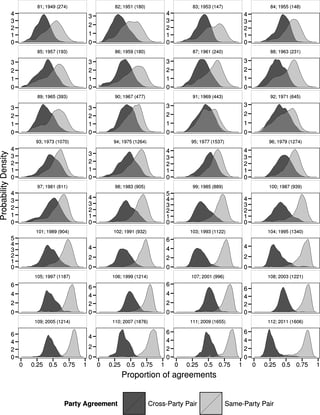Traditionally, yes, but not much anymore
One way would be to look at how often members of one party vote the same as members of another party. In this 2015 paper published on PLOS One: The Rise of Partisanship and Super-Cooperators in the U.S. House of Representatives, Andris et.al. do just this with data from 1949-2018:
We define a network of over 5 million pairs of representatives, and compare the mutual agreement rates on legislative decisions between two distinct types of pairs: those from the same party and those formed of members from different parties.
In the plot below (figure 1), the authors plot the probability that 2 representatives will vote the same way on a vote, split by whether they belong to the same party (light grey) or different parties (dark grey). As you can see, from 1949 (the first year studied) through 1981, there is substantial overlap between the 2 distributions, meaning that members of the same party often disagree at a similar rate to members of a different party.
Beginning in the 1980s, however, these peaks separate, showing that representatives are becoming more polarized and more likely to vote with their party.
The takeaway from this is that while, traditionally, US politicians were quite willing to break with their parties and work with members of their opposition, this behavior has all but disappeared in recent decades.
